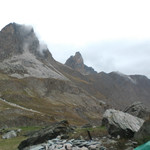|
Tirano and "Castellaccio" surrounding walls
Historical and architectural information: Before the worsening of the Grigionis’ menace to conquer the valley in the XV century Ludovico the Moor entrusted his architects with the duty to strengthen the defensive system of the two cities near the mountain passes, Tirano and Chiavenna. Thanks the whole valley’s economic help, between 1492 and 1499 Tirano was fortified according to the given planning hints: of such defensive system the Milan Gate, the Bormio Gate, the Poschiavo Gate and the so-called “Castellaccio” (Bad Castle, n.d.T.), also known as “Saint Mary’s Castle” because at the time a small church dedicated to the Virgin existed nearby, remain to be seen. The Milan Gate has well preserved its original aspect in time; today, the stone structure can still be seen, with its round arch bearing an external opening and the staircase leading to the upper floor. The Poschiavo Gate, at the entrance “old bridge”’s entrance La Porta Poschiavina, all’imbocco del “ponte vecchio” sull’Adda, presenta due figure dell’Uomo Selvatico. La Porta Bormina, al margine del centro storico della città, è in direzione dell’Alta Valle. Del Castello, invece, rimangono alcuni muri e locali interrati e la torre quadrata, con finestre di varia foggia e feritoie. Mura e Castello furono abbattuti dopo il 1512, quando i Grigioni riuscirono a conquistare Valtellina e Valchiavenna, annettendole al loro territorio.Information for visits: Free admission. Contacts: Tirano Tourist Office Piazza Stazione - 23037 Tirano (SO) Tel. +39 0342 706066 Fax +39 0342 706066 infotirano@provincia.so.it |



